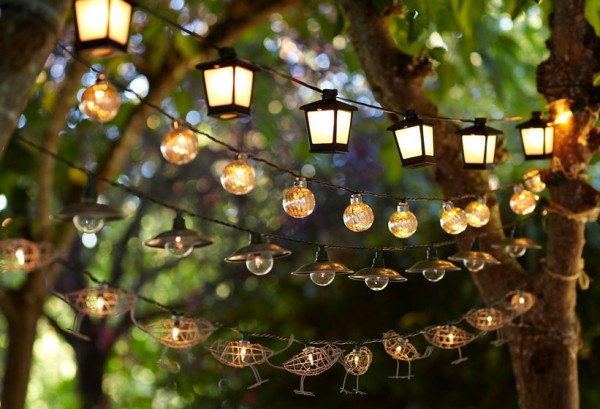Outdoor lighting transforms your home’s exterior into a visually appealing and secure environment. Well-placed lights enhance the beauty of your property, extend the usability of outdoor spaces after dark, and increase safety by illuminating driveways and walkways and discouraging potential intruders. This blog delves into the strategic placement of outdoor lights to maximize these benefits, covering everything from the basics of outdoor lighting fixtures to advanced lighting techniques.
What is Outdoor Lighting?
Outdoor lighting encompasses a variety of light fixtures designed to enhance the functionality, safety, and aesthetics of exterior spaces. From creating inviting atmospheres to highlighting the architectural details of your home through exterior architectural lighting, the right lighting setup not only ensures your outdoor spaces are well-lit during evening hours but also boosts curb appeal and property value. This approach to illumination can transform the look of your property, emphasizing its best features and creating a stunning nighttime presence.
Types of Outdoor Lighting Fixtures
Outdoor lighting fixtures come in several types, each serving specific purposes in landscape lighting design:
- Path Lights: These are small fixtures placed along walkways and paths. They provide safety by illuminating steps and edges, guiding the way during nighttime, and adding a welcoming glow to your home’s approach.
- Accent Lights: Used to draw attention to specific features in your garden, accent lights can highlight trees, architectural details, or other objects of interest. They are ideal for creating focal points and enhancing the natural beauty of your outdoor space.
- String Lights: Versatile and festive, string lights are commonly used in seating areas and across trees or shrubs to create a lively, inviting atmosphere. Their soft glow adds a magical touch to any evening gathering.
- Post Lights: Typically placed at strategic points around outdoor living spaces, post lights illuminate larger areas from above and are perfect for ensuring larger parts of your yard or garden are well-lit, adding both style and functionality.
By selecting the appropriate types of lights and placing them wisely, you can transform your outdoor living space into a beautiful and secure extension of your home. These fixtures not only enhance the landscape but also ensure that your outdoor areas remain functional and inviting after dark.
The Art of Placing Landscape Lighting
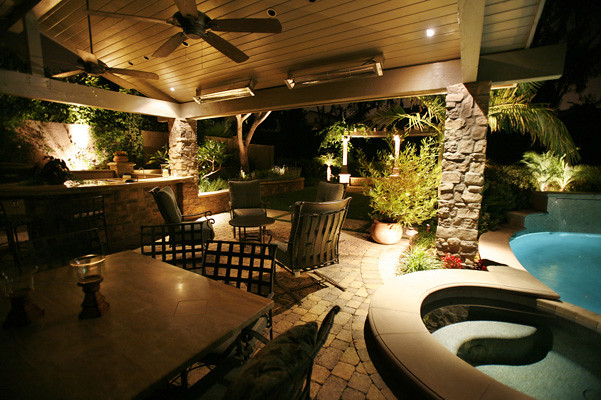
Landscape lighting installation is both an art and a technique that enhances the visual appeal of your home while providing functional benefits such as safety and security. Effective placement of landscape lighting requires understanding the interplay of light and shadow, the architectural features of your space, and the natural elements within it. By strategically positioning lights, you can transform an ordinary outdoor area into a captivating scene, highlighting the best features of your home and garden.
Highlighting Natural Beauty and Garden Features
When it comes to illuminating natural beauty and garden features, the goal is to enhance the existing landscape without overpowering it. Place lights at both the base and among the branches to create a dramatic effect that emphasizes the shape and texture of the tree. For smaller garden features such as shrubs, flower beds, or small sculptures, use small fixtures with low wattage to avoid unwanted glare. For natural elements like rocks or water features, use lights at different angles to highlight their unique textures and colors.
Enhancing Architectural Elements
Lighting architectural elements requires a balance between functionality and aesthetics. Use lighting to create a welcoming entrance. Position lights on either side of the door or overhead to ensure the area is well-lit, which adds safety and highlights the doorway as a focal point. Wash lighting works well on flat surfaces, casting an even light that brings out the texture of the material, whether brick, stucco, or stone. For specific architectural details like columns, moldings, or carvings, use direct lighting to draw attention and create shadows that emphasize these features.
Ensure pathways and walkways are well-lit to add safety and guide visitors through your landscape. Path lights should be placed along the sides of the path, spaced evenly to provide a continuous light source that illuminates the way without being intrusive.
Through these methods, you can use landscape lighting to not only showcase the beauty of your outdoor spaces but also enhance the security and functionality of your home environment.
Practical Tips for Positioning Lights
Positioning outdoor lighting effectively not only enhances the beauty of your landscape but also improves safety and functionality. Careful consideration of where to place lights can dramatically transform your outdoor space into an inviting and secure environment. Here, we explore several practical tips for strategically placing lights to illuminate pathways, highlight focal points, and create enchanting effects.
Pathway and Walkway Lighting Ideas
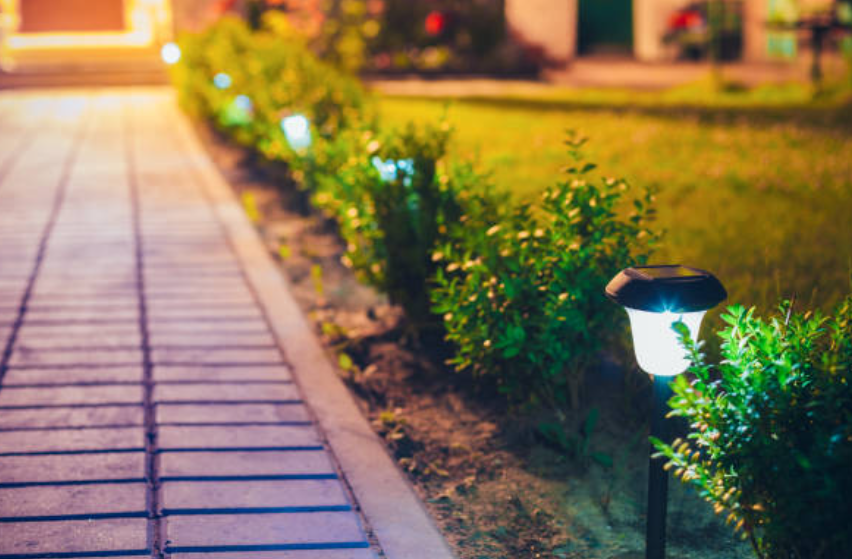
Proper illumination of pathways and walkways is crucial for safety and adds a visual appeal that guides guests through your outdoor spaces. Here are some best practices:
- Even Spacing: Place pathway lights at equal distances along the path to create a harmonious and well-lit route. This prevents patches of darkness that could pose hazards.
- Low-Wattage Lights: Use low-wattage lights to ensure the path is illuminated without being overly bright or glaring. This provides a pleasant experience while walking through the area at night.
- Downward Lighting: Install lights that cast their beams downward to illuminate the path while minimizing light pollution and glare, enhancing both beauty and functionality.
Focusing on Focal Points
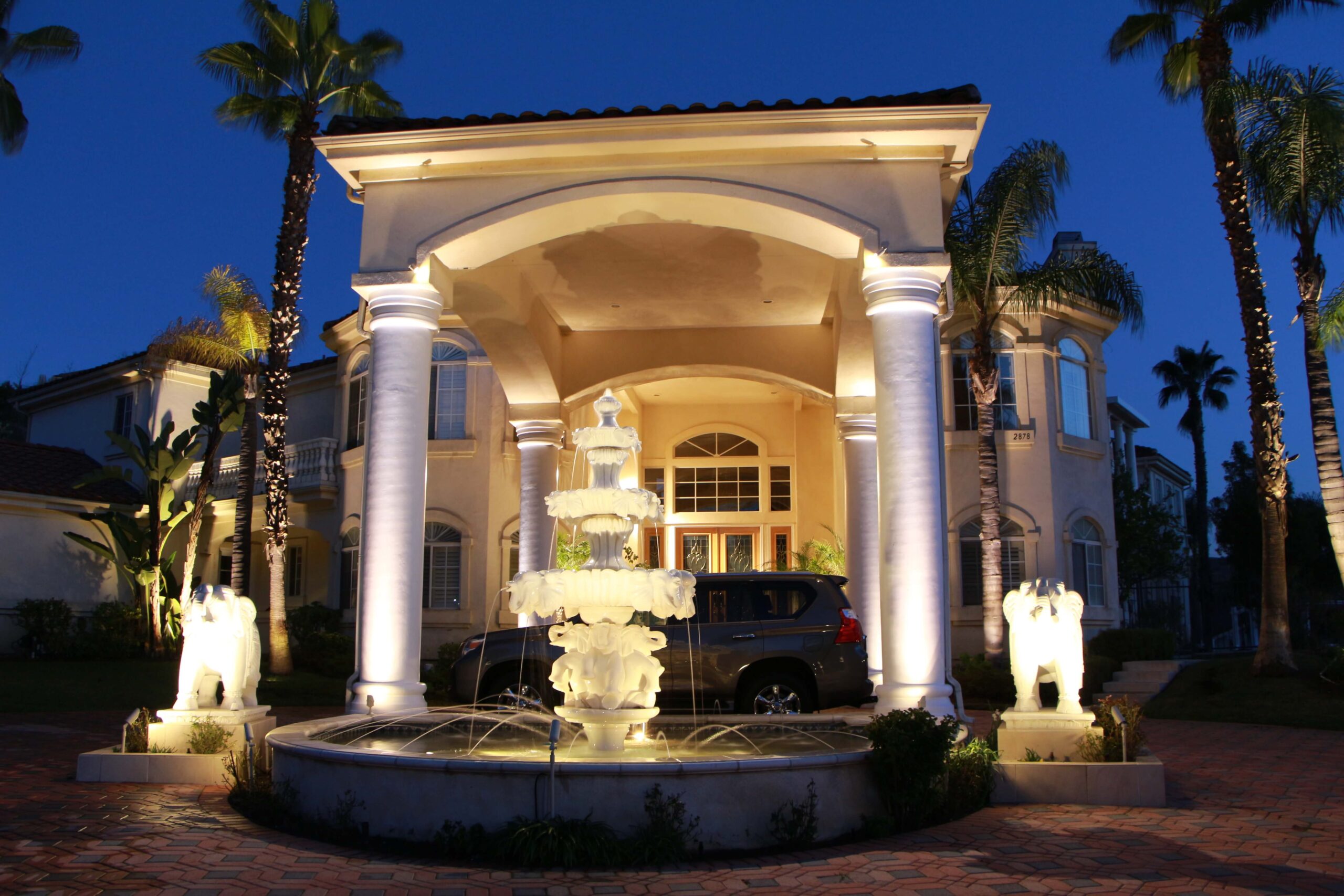
Drawing attention to specific features like sculptures or water features can create captivating visual highlights in your garden:
- Strategic Placement: Position lights so that they focus directly on the object you want to highlight, ensuring the light source itself remains hidden to maintain the magical effect.
- Use of Contrast: Employ backlighting or side lighting to form dramatic shadows or silhouettes, which enhance the visual impact of the feature.
- Adjustable Fixtures: Utilize fixtures that can be adjusted in terms of angle and intensity, allowing you to experiment with different lighting effects as your garden matures or as objects are moved.
Lighting Techniques for Dramatic Effects
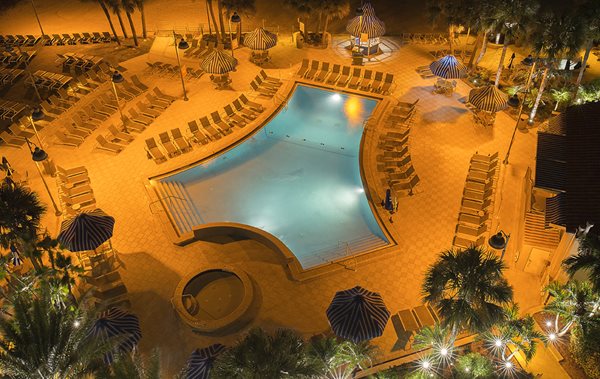
Enhancing your outdoor space with dramatic lighting effects can transform an ordinary setting into an extraordinary scene. These techniques focus on maximizing impact through the interplay of light and shadow.
Creating Shadows and Silhouettes
Creating shadows and silhouettes adds depth and intrigue to your outdoor lighting design. By positioning lights at ground level and aiming upwards, you can cast long shadows of trees, plants, or statues, which elongates forms and creates dynamic visual interest. Alternatively, placing a light behind an object and directing it towards a backdrop forms a silhouette, emphasizing the outline and form of the feature against a lighter background.
Utilizing Indirect Lighting
Utilizing indirect lighting softens the outdoor environment, reducing harshness and creating a welcoming atmosphere. This can be achieved by using natural surroundings like walls or floors to bounce light, which softens the effect and disperses it evenly. Tucking lights behind elements or slightly below eye level illuminates spaces without the light source being directly visible, enhancing the experience without the distraction of visible fixtures.
Enhancing Textural Details
Highlighting the textures of walls, foliage, and other surfaces can add a layer of richness to your landscape. Positioning lights close to the surface creates a grazing effect that highlights textures like bark, leaves, or masonry. Using varying intensities of light to play off different materials’ reflective properties enhances the natural contrast found in the landscape.
Selecting the Right Fixtures for Each Area
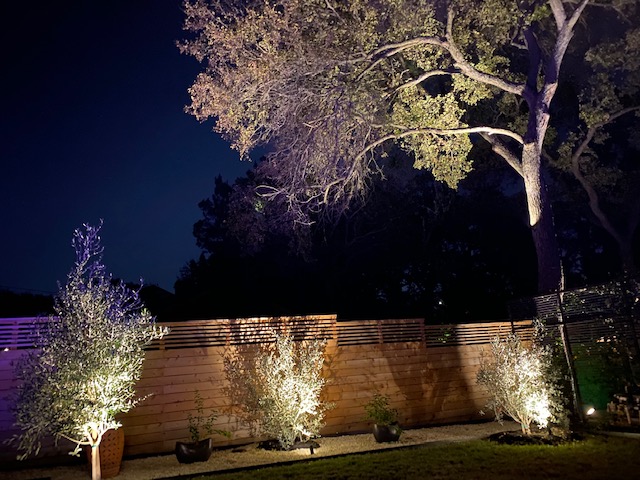
Choosing the appropriate lighting fixtures for your outdoor space is crucial for achieving both aesthetic appeal and functional utility. The right fixtures not only complement your home’s architecture and landscaping but also address specific needs such as visibility, security, and energy efficiency. Below, we explore how to match various types of fixtures to their ideal locations and consider energy-efficient options.
Fixture Types and Their Best Uses
To enhance the functionality and beauty of your outdoor areas, it’s important to select the appropriate type of lighting fixtures for each location:
- Path Lighting: Small, low-lying lights such as pathway lights are ideal for illuminating walkways and garden paths, ensuring safe navigation and adding a decorative touch.
- Accent Lighting: Spotlights and floodlights are perfect for accentuating architectural features, sculptures, or prominent trees. These fixtures can be adjusted to focus light exactly where it is needed.
- Ambient Lighting: For general illumination in outdoor living areas, hanging lights, wall-mounted fixtures, or post lights provide a widespread light that creates an inviting atmosphere.
- Task Lighting: In areas where activities occur, such as outdoor kitchens or grilling spots, brighter, more direct lights are necessary to ensure adequate visibility for safety and convenience.
Installation Tips for Outdoor Lighting

Installing outdoor lighting involves careful planning and consideration of both design and safety. Whether you decide to install the lighting yourself or hire professionals, understanding the basics can help ensure a successful setup.
DIY vs. Professional Installation
Deciding between DIY and professional installation depends on the complexity of your lighting design and your personal comfort with electrical work. DIY installation is suitable for simpler systems like solar lights or plug-and-play LED setups. These options often require minimal technical skills and can be a fun weekend project. On the other hand, professional installation is recommended for extensive lighting systems, especially those that require electrical wiring or integration with home automation systems. Professionals ensure that the installation complies with local safety codes and is set up for optimal performance.
Safety First: Electrical Considerations
When it comes to electrical considerations, safety should always be the top priority. Handling electrical components safely is paramount when installing outdoor lighting. First and foremost, ensure all connections are waterproof to prevent moisture from causing electrical shorts. This is crucial for maintaining the longevity and safety of your outdoor lighting system.
Advanced Lighting Strategies
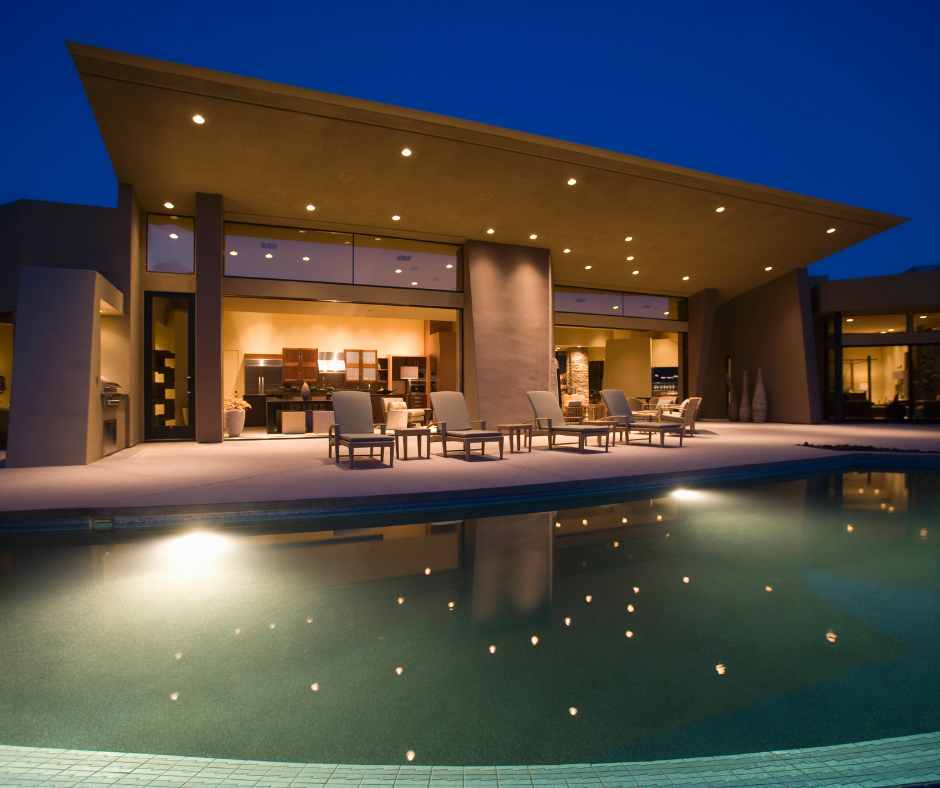
Advanced lighting strategies can elevate your outdoor lighting from merely functional to truly phenomenal. These strategies not only improve the illumination of your landscape but also tailor the lighting to serve both practical needs and artistic expressions.
Using Timers and Sensors
Incorporating timers and sensors into your outdoor lighting system offers significant benefits in terms of energy efficiency and convenience. These technological enhancements help in managing your lighting more effectively, ensuring that energy consumption is minimized while still providing ample illumination when needed.
- Timers: By setting timers on your landscape lighting, you can control exactly when your lights turn on and off. This is particularly useful for ensuring that lighting is only used during the evening hours or specific times when you need visibility and security around your house.
- Motion Sensors: Adding motion sensors to strategic areas within your outdoor spaces can drastically improve the functionality of your lighting. Sensors can be placed along walkways, near entry points, and around valuable landscaping features.
Exploring Color and Texture with Lighting
The use of varied colors and textures in outdoor lighting can transform the overall ambiance of your outdoor spaces, creating moods and highlighting special features:
- Colored Lights: Colored LED bulbs can be used to accent specific elements of your garden or to set the mood for different occasions. For instance, soft blue lights can evoke a calm, serene atmosphere, while vibrant reds can add energy and excitement. For a more subtle and sophisticated approach, consider incorporating outdoor LED soffit lighting, which can provide both colored and white light options to elegantly illuminate the perimeter of your home while complementing your garden’s lighting scheme.
- Textured Lighting: Fixtures with textured glass or those that allow for adjustable covers can project intriguing patterns and shadows, dramatically enhancing the visual interest of your environment.
These techniques allow you to create a more inviting, secure, and visually appealing outdoor environment, making your home stand out and providing enjoyment during both day and night.
Mastering Outdoor Lighting for Beauty, Functionality, and Security
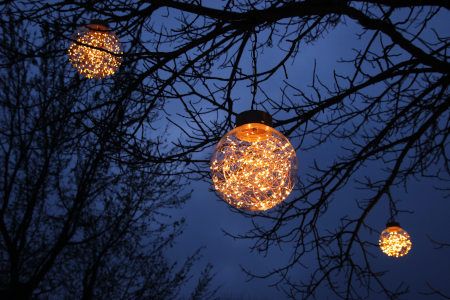
Throughout this guide, we’ve explored a comprehensive approach to placing, maintaining, and innovating outdoor lighting. From creating dramatic shadows with uplighting to illuminating walkways with subtle pathway lighting, we’ve covered a spectrum of outdoor lighting ideas that transform simple gardens into stunning landscapes. The power of well-placed landscape lighting is truly transformative, turning your outdoor spaces into inviting retreats that shine long after sunset.
Remember, effective outdoor lighting is more than just visibility—it’s about crafting an atmosphere. Whether you’re using up lighting to accentuate trees or subtle fixtures to guide guests along a meandering path, each element contributes to the overall ambiance of your outdoor living space.

